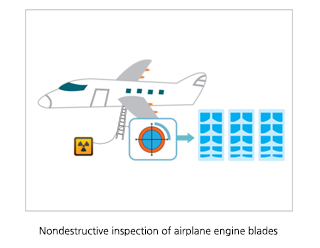- Definition of Radiation
- Radiation in Daily Living
- Measurement of Radiation
- Utilization of Radiation
- Radiation Safety
Learning More about Radiation
What is radiation like?
Radiation is always with us, like the air and water.
Radiation is a part of nature that cannot be separated from humans.
The amount of radiation from nature is extremely small,
and thus humans can live with it without any problems.
Unknowingly, we are receiving radiation from food and air.
Radiation is a part of nature that cannot be separated from humans. The amount of radiation from nature is extremely small, and thus humans can live with it without any problems. Unknowingly, we are receiving radiation from food and air.
Radiation is an 'energy flow' of high power.
Atoms or nuclei in an unstable state have the tendency
to move to a stable state.
The energy emitted during this process is called 'radiation.'
Radiation is invisible, odorless, and intangible.
However, radiation can easily pass through our body or materials,
and can damage the DNA (material containing genetic information) in our body.
Radiation is an 'energy flow' of high power.
Atoms or nuclei in an unstable state have the tendency to move to a stable state. The energy emitted during this process is called 'radiation.' Radiation is invisible, odorless, and intangible. However, radiation can easily pass through our body or materials, and can damage the DNA (material containing genetic information) in our body.
Learn More
Radiation
The bunch of energy that an object at a high energy state emits to become stable is comprehensively called radiation.
In addition to the radiation emitted by atoms, infrared rays from hot objects, visual light, and electromagnetic
waves
emitted by electromagnetic vibration are also radiation in the widest sense.
- (Atom) : : The basic unit particle of a substance that may not be further divided by a chemical method.
- Atomic nucleus : The particle at the center of an atom
Ionizing Radiation
Radiation with high enough energy to ionize the atoms of a substance is called ionizing radiation.
- Ionizing radiation: X-ray, α-particles, β-particles, γ-ray, neutrons, protons, etc.
- Ionization: The process where an electron bound in an atom absorbs external energy, which breaks the bond to the atom, separating it. The atom becomes an ion. Simply put, the bond is broken in the ionization process through a reaction with another substance.
Non-ionizing Radiation
Radiation that does not have the capability to ionize is called non-ionizing radiation.
- Non-ionizing radiation: Infrared ray, visual light, electromagnetic wave, microwave, ultrasound, etc.
Radiation refers to
rapidly flying particles or a magnetic wave having a very short wavelength.
There are many examples of radiation, including α-ray, β-ray, γ-ray, and X-ray.
Their most outstanding characteristic is that they have high energy and high capability to pass through an object (penetrating power).
The high energy and penetrating power of radiation is utilized in various fields, including cancer treatment and
baggage checks.
Because the penetrating power varies depending on the types of radiation, various structures can be used to
block radiation.
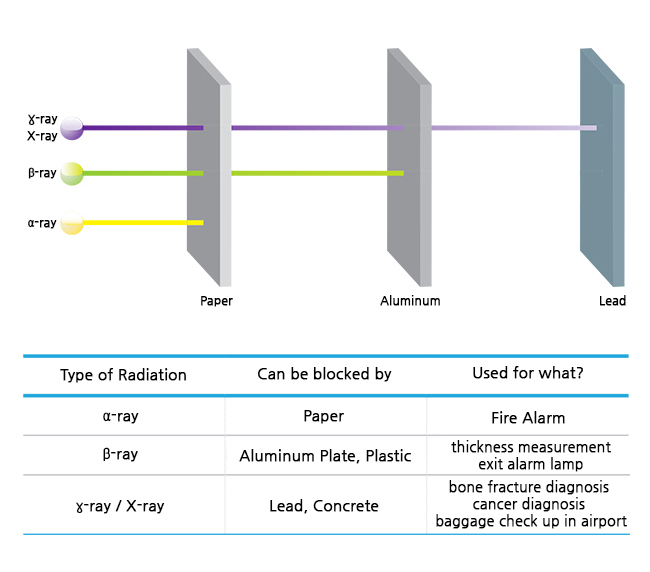
Learn More
α(alpha)-ray
α-rays usually come from natural radioactive substances.
Although the energy is relatively high, α-rays may not travel far because of their high weight.
Therefore, α-rays can be easily blocked by a sheet of paper.
- Radioactive substances refer to substances emitting radiation.
β(beta)-ray
β-rays are electrons emitted from radioactive substances. A β-ray is much smaller and faster than an α-ray.
β-rays can be blocked by aluminum and plastic.
γ(gamma)-ray and X-ray
γ-rays and X-rays are electromagnetic waves, but much stronger than general electromagnetic waves.
Therefore, γ-rays and X-rays can easily penetrate an object.
γ-rays, which can penetrate into our body much easier than X-ray, are used in medicine, including cancer treatment.
γ-rays may be weakened or blocked by lead or concrete.
How to Describe the Strength of Radiation
Sievert (Sv)
Unit describing the degree of effect to a person from radiation exposure
Sievert is a unit that represents the degree of exposure to radiation.
For natural radiation, a Sievert is a unit that is too large.
Therefore, a millisievert (mSv), which is one thousandth of one Sv, is used.
The external and internal effects of radiation are expressed in Sv.
For example, a person undergoing an X-ray in a hospital receives about 0.1 mSV of radiation.
* 1 Sv = 1000 mSV
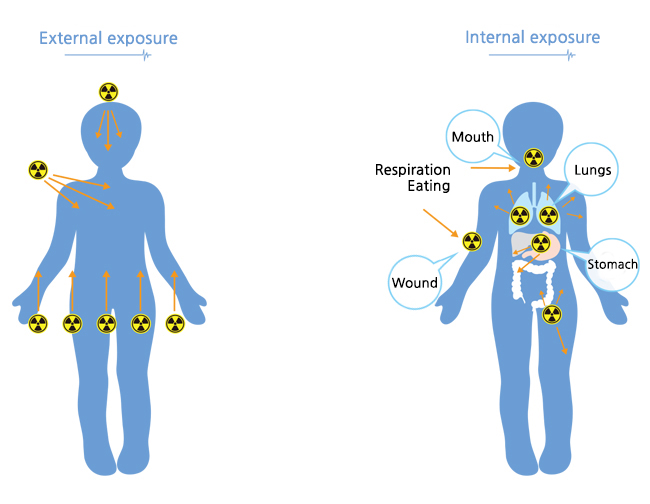
Becquerel (Bq) and Curie (Ci)
Basic units representing the amount of radioactive substances
The amount of radiation emitted by a radioactive substance in unit time is expressed by Becquerel (Bq) and Curie (Ci).
The standard unit, Bq, is often used.
When 100 Bq of radioactive substances is included in 1 kg of food or water, the amount is expressed as 100 Bq/kg.
For example, bananas usually contain about 130 Bq/kg of potassium-40, which is a substance that emits radiation.
Learn More
Radioactivity
Radioactivity refers to the capacity of emitting radiation.
Radioactive
A substance emitting radiation is radioactive.
Radioactive substance
Radioactive substance refers to a substance having the characteristic of emitting radiation.
Radiation exposure (exposure)
Radiation exposure refers to the exposure of the human body to radiation, and includes external exposure and internal exposure.
External exposure vs Internal exposure
External exposure refers to exposure to radiation from outside of the human body, while internal exposure refers to exposure to radiation from radioactive substances that have entered into the human body through wounds, respiration, or food intake.
Despite the different causes of exposure, external exposure and internal exposure usually have the same effect on the body if the value expressed in the unit of Sv is the same.
Exposure dose (dose)
Exposure dose refers to the amount of radiation exposed to a person
Being familiar with the units
The unit of Becquerel is from 'Antoine Henri Becquerel.'
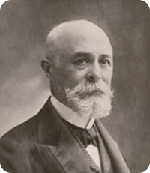
-
Antoine Henri Becquerel, a French physicist, focused on optical studies of infrared rays and fluorescence in his early career.
Learning of Röntgen's discovery of X-rays in 1895, Becquerel discovered radioactivity in the spring of the following year
He discovered natural radioactivity, and named the radiation emitted from uranium a Becquerel ray.
He further studied radiation and found that a part of radiation, being refracted by an electric field or a magnetic field, was different from an X-ray. He received the Nobel Prize in Physics in 1903 with the Curies.
The unit of Curie is from 'Marie Curie.'

-
Marie Curie was a Polish and naturalized-French physicist, and married to Pierre Curie, who was an experiment instructor at the School of Physics and Chemistry. They conducted radium studies together for several years.
The Curies discovered that irradiation of cancerous tissues of an animal skin removed the cancerous tissues, and then the skin was regenerated, although the wounds remained.
This was because the cancer cells were destroyed by radiation.
Later, physicians started to use radium to cancer treatment for patients.Radium not only caused wounds but also treated cancers.
The Curie Therapy was a ground-breaking discovery.
Marie Curie was the first woman to win a Noble Prize.She shared the 1903 Nobel Prize in Physics with her husband for their radium study, and received the 1911 Nobel Prize in Chemistry alone
Learn More
Becquerel ray
Becquerel ray refers to the radiation emitted from natural radioactive substances, including the three types of radiation described above (α-ray, β-ray, and γ-ray).
Marie Curie's Legacy
All the satellites and spaceships moving through space require a system that generates a sufficient amount of heat
to protect the people and machines from coldness.
In the cold vacuum state of outer space, the temperature is extremely low, and no battery can work properly.
A fuel cell is a substitute.
In several flights in the past, a fuel cell was effectively used to provide the necessary electricity and heat.
Special radioisotopes (elements emitting radiation) have been used for the same purpose.
Plutonium-238, an ideal isotope for fuel cells, decays by alpha-ray emission.
Let's remember that Marie Curie's great legacy, which is radiation, played a critical role in leading us to the space age.
Natural Radiation and Artificial Radiation
Natural Radiation and Artificial Radiation
Same Radiation Made by Different Methods
Radiation is classified as natural radiation and artificial radiation.
‘Natural radiation’ comes from elements such as uranium, thorium, and radium, which have existed since the birth of
the earth.
Interestingly, a very small amount of natural radiation comes from not only our bodies but also from space and our food.
Human-made radiation is called 'artificial radiation.' An example of artificial radiation is the radiation coming from
the X-ray machine used in hospitals.

Learn More
Natural Radiation
Natural Radiation includes α-rays, β-rays, and γ-rays as well as cosmic rays from space, and the radiation from the radioactive substances in the ground, and building materials.
The exposure dose to natural radiation is dependent on the region. In some regions, such as Iran, Brazil, and India, the annual dose exceeds 10 mSv.
Considering that the average annual dose of natural radiation is about 2.4 mSv, the dose in those regions is higher than
the annual average dose.
The reason will be found in 'Chapter 2. Amount of Radiation in Different Regions.'
Comparison of Natural Radiation and Artificial Radiation
The effects of radiation on the human body from natural radiation and artificial radiation may be compared
as described below.
Exposure to artificial radiation at a high dose for a long time may produce a severe effect, which should be carefully avoided.
However, in medical treatment, intensive radiation is applied by focusing on cancer cells, and thus the normal cells
are little affected.
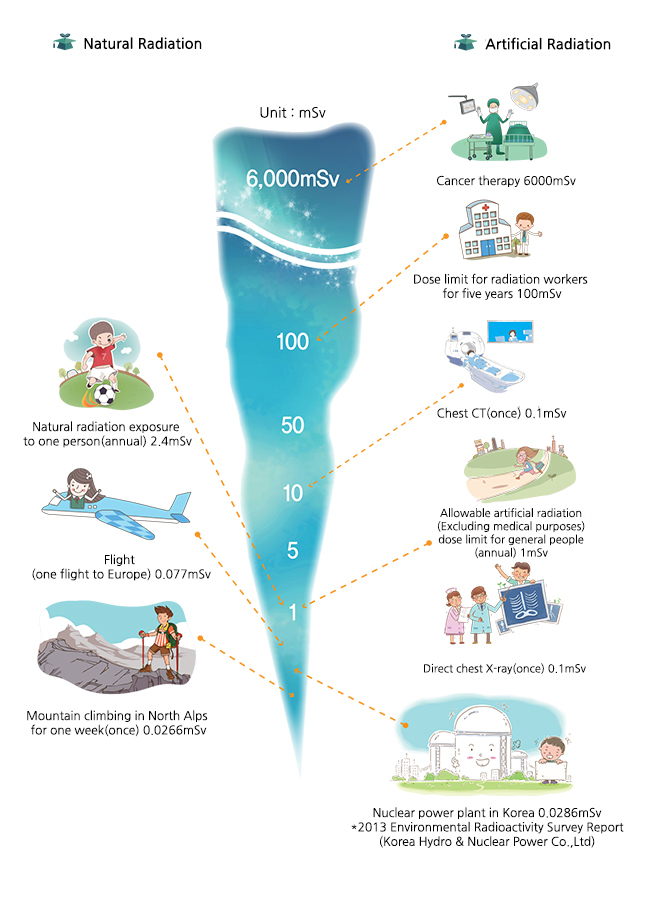
Learn More
Cancer Radiotherapy
The artificial radiation used for cancer radiotherapy in hospitals is focused on cancer cells to remove the cancer cells.
Since the penetrating distance of the medical radiation is not long, the surrounding normal cells are little damaged.
Radiation Dose
Radiation dose comprehensively refers to the amount of radiation exposure, including the irradiation dose,
(strength of α-ray and X-ray in the air), absorbed dose (radiation energy absorbed by a material),
and equivalent dose (amount of radiation received by human organs).
Radiation Exposure (Exposure)
Radiation exposure refers to the exposure of the human body to radiation.
News articles sometimes describe persons exposed to radiation.
Exposure Dose (Dose)
Exposure dose refers to the amount of radiation received by a person through exposure.
Unit of Sievert (Sv)
1 Sv = 1000 mSv
Sv is a unit representing the amount of exposure of a human body to radiation.
Since Sv is too large a unit, a millisievert (mSv), which is one thousandth of one Sv, is often used.
Radiation in Space, Atmosphere, and the Ground
Radiation in Daily Living
We are exposed to radiation in our everyday life.
Everyone in the world is exposed to 2.4 mSv of natural radiation annually.
On average, we receive a total of 2.4 mSv radiation, including 0.35 mSv from space, 0.4 mSv from the ground,
1.3 mSv through the air by respiration, and 0.35 mSv from food.

We cannot avoid natural radiation, but the amount is extremely small.
Therefore, the natural radiation does not cause any health problems in our lifetime.
For example, we receive radiation of 0.07 mSv during a round trip flight between Seoul and Europe,
and less than 0.0286 mSv in a year at a location near a nuclear power plant.
That amount is negligible in comparison with the annual exposure to natural radiation (2.4 mSv).
* Results from 2013 Environmental Radiation Survey (Korea Hydro & Nuclear Power)
Learn More
Natural Radiation
Natural radiation comes from elements that have existed since the birth of the earth, including uranium, thorium, and radium.
Artificial Radiation
Artificial radiation refers to human-made radiation, including radiation from the X-ray imaging machine used in hospitals.
Unit of Sievert (Sv)
Sv is a unit representing the amount of exposure of a human body to radiation
Since a Sv is a large unit, a millisievert (mSv), which is one thousandth of one Sv, is often used. 1 Sv = 1000 mSv
1 Sv = 1000 mSv
Radiation from Food
Radioactive substances are contained in our everyday food.
Radioactive substances are also contained in our daily food, such as vegetables, meat, and fish.

'Radioactivity' is like an invisible beam.
'Radioactive substances' means substances that have the characteristic of emitting radiation,
and 'radioactivity' refers to the ability to emit radiation.
Radiation is like the light from a bulb. The light-emitting capability of a bulb is represented by the unit of Watt,
while the radiation-emitting capability of radioactive substances is called radioactivity.
Radiation Coming from Our Body
Our body also contains radioactive substances.
Our body also contains radioactive substances existing in the nature.
Natural radioactive substances are elements that are indispensable to animals and plants.
Natural food basically contains natural radioactive substances.
For example, potassium, one of the minerals existing in the nature, is indispensable to living organisms for
transmitting information through the nervous system.
Potassium is known to be about 0.2% of our body weight, and the ratio is generally regulated to stay constant.
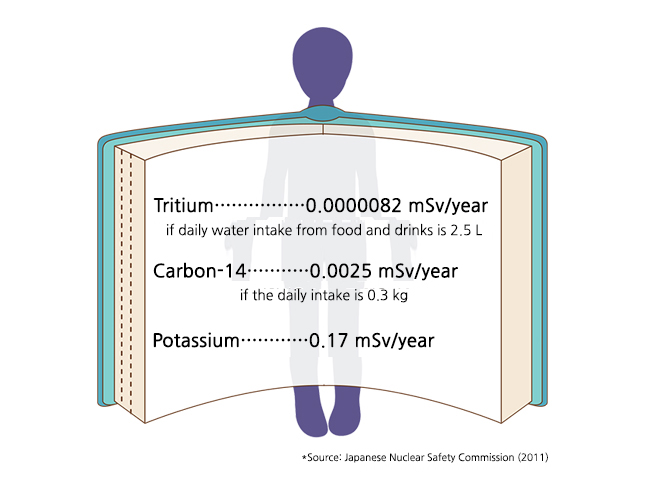
Amount of Radiation Depending on Region
The amount of natural radiation is dependent on the regions in the world.
In some regions of the world, the amount of natural radiation is several times higher than Korea.
Many factors are involved in the high level of natural radiation in those regions.
For example, in Ramsar, Iran, the natural radiation level is high because radium, a radioactive substance,
is discharged from hot springs and accumulates.

Visualizing Radiation
Radiation is invisible and odorless, but it can be measured using instruments.
When an object is irradiated, an electric discharge or light emission may occur, or a photographic image may be obtained. An X-ray image is a good example.
A radiation instrument is an instrument used to measure the amount of radioactive substances or the amount of
radiation in the air, using these reactions.
Many types of radiation instruments are available, and they are necessary for measuring exposure dose, or to survey
the radiation level at certain places.
However, the right type of radiation instrument needs to be selected depending on the purpose, to obtain a useful measurement.
A cloud chamber is painted black and filled with ethanol vapor that is cooled down.
The ethanol vapor is kept in a state where the vapor may be turned into the liquid by a small stimulus.
Then, when the radiation penetrates the chamber, the trace of the radiation penetration appears, like the condensation trail of an airplane, showing the trajectory of the radiation.
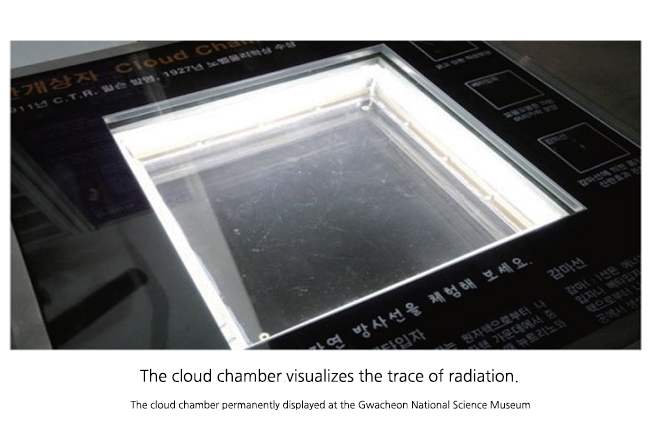
Measuring the Amount of Radiation in Space
A Nal scintillation survey meter is used to measure the amount of radiation (intensity) in a specific place (space).
The measurement is performed several times at a height 1 m above the ground surface.
The Nal scintillation survey meter measures the radiation intensity.
The amount of external radiation may be measured in a specific place.
A personal dosimeter is worn by a radiation worker immediately before starting work, and is used to measure the exposure dose of the worker during their time at work.
The personal dosimeter is attached to the chest or other body part to measure the external radiation dose.
Types of personal dosimeters include a film badge and thermoluminescent dosimeter (TLD), which require reading
after measurement, and a pocket dosimeter and alarm meter, which allows the worker to check the dose right away.
Recently, pocket dosimeters are being replaced by electronic dosimeters.
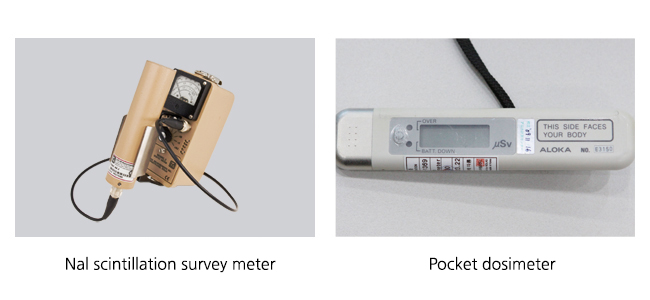

Measurement of radiation in food and the human body
The amount of radiation can be measured for each of the radioactive substances contained in food and other materials.
A high-purity germanium semiconductor detector is used to detect the radiation analyze the amount of radiation from each of the radioactive substances included in food and other materials.
A whole body counter directly measures the radiation (gamma-ray) emitted from the radioactive substances accumulated in the human body, and shows the result in numerical values.
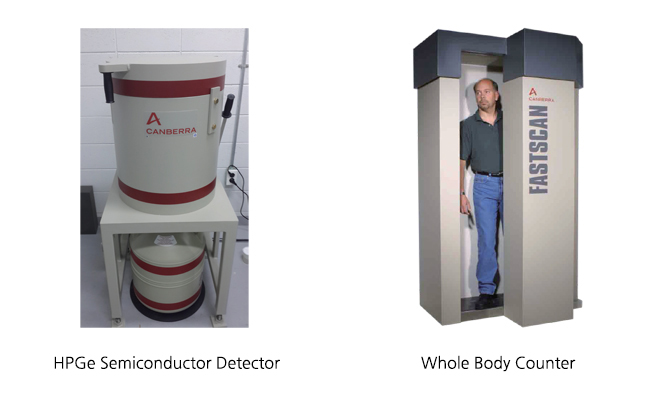
Learn More
New Drug Development
Before a newly developed drug is administered to patients, numerous tests need to be carried out to investigate the working mechanism of the new drug on the target diseases, and potential adverse effects.
Radioisotopes may help the process with their unique imaging (emitting) characteristics, allowing viewing of the passage of
a drug in the body.
In the US, radiation technologies are used to investigate over 80% of new drugs.
Radiation Is Beneficial To Us
Most people have vague fears about radiation, because the word 'radiation’ reminds them of the danger of
atomic bombs or nuclear accidents.
However, we are living with radiation at a very low level, from sunlight or in foods such as bananas and milk.
In addition, radiation is widely used in various fields including medicine, industry, and research,
and so we directly benefit from radiation.
For example, radiation is very useful in medical services, such as the diagnosis of diseases and the treatment of cancers. Radiation is also very useful in industrial areas, including the airport baggage check system and radiation sterilizers.
Because radiation is widely used in many parts of daily living, it is closely related to our life.
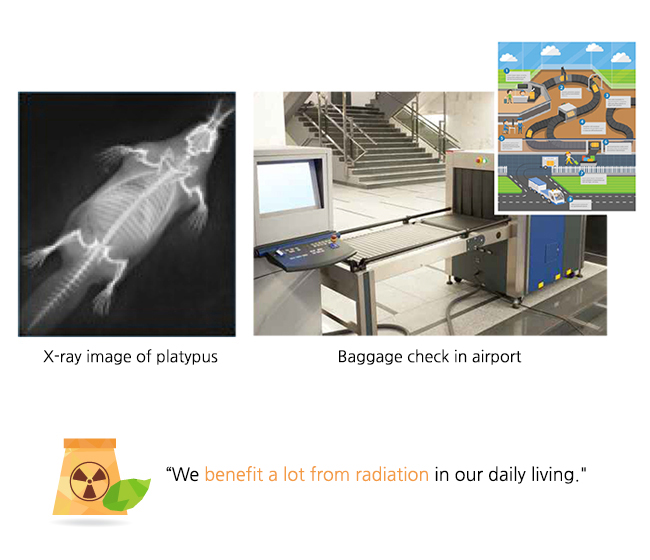
Learn More
Is an object at a high energy level properly called radiation or radioactivity?
- Radiation: Flow of energy coming from radioactive substances
- Radioactivity: Activity of radioactive substances, or strength of radiation coming from radioactive substances
Sievert (Sv)
- Unit describing the degree of effect to a person exposed to radiation
- For natural radiation, a Sievert is a unit that is too large.
Therefore, a millisievert (mSv), which is one thousandth of one Sv, is used.
1 Sv = 1,000 mSv
Radiation, Our Health Guard
Diagnosis through X-ray Radiography
- Since the discovery of X-rays, a type of radiation, they have contributed to the saving of numerous lives. X-rays allow the structure and state of the internal body to be viewed, and are used for the diagnosis of various diseases. When we have a leg fracture, get a severe cold, or have a severe abdominal pain, what the doctors recommend first is X-ray radiography.

Diagnosis by Nuclear Medical Imaging (PET, PET-CT)
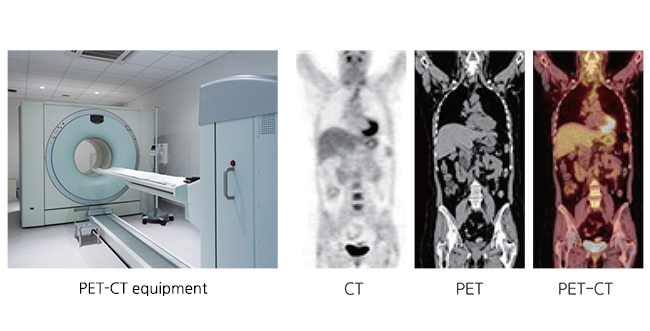
Positron Emission Tomography (PET) using radiopharmaceuticals allows viewing of parts of the body that may not be effectively inspected by X-ray radiography.
In particular, PET-CT, the combination of PET with X-ray based CT, is very helpful in the discovery and treatment of cancers.
Learn More
Radiation Imaging Diagnosis Equipment
1. X-ray radiography equipment
2. CT (Computed Tomography)
• CT instrument
- Diagnostic equipment improving the problem of planar X-ray radiograph
3. PET
• PET equipment
- Diagnostic equipment using radioisotopes
4. PET-CT
• PET-CT equipment
- PET-CT is the combination of a PET scanner and X-ray CT. The functional images allow cancers to be located.
Radiation, the Watchman for Industry
Radiotherapy, the Edge-Cutting Medical Technology
Anticancer treatment using radiation
In addition to surgery and anticancer drugs, radiation is one of the three major methods of cancer treatment.
Radiation is directed to cancer cells to treat cancer.
instruments, and local irradiation of a limited part of the body by placing a radiation generator on the body surface.

Anticancer treatment using radiopharmaceuticals
Radioisotopes can also be placed in the body to limit irradiation to a specific area for cancer treatment.
In thyroid cancer, radioactive iodine entering into the body is accumulated in the thyroid, and the radiation from
the iodine attacks the cancer cells, providing therapeutic effects.

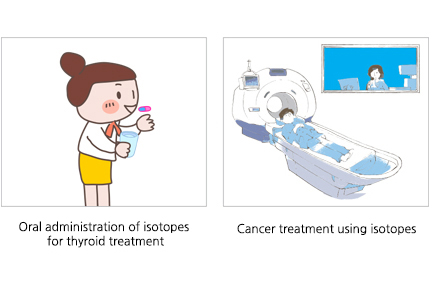
Freeze, illegal substances!
Defect testing
A method of detecting engineering defects without destroying the material is called 'defect testing.'
A defect test performed with radiation allows internal cracks or defects to be examined without destroying or disassembling an object.
In technical terms, defect testing is referred to as 'nondestructive inspection,' and is a representative technology that utilizes the unique capacity of radiation to penetrate a material.
Security Screening
Security screening using radiation is performed at key facilities including airports and ports to prevent the entry and export of illegal substances. In the US, since the September 11th attack, X-ray security screening is performed on the entire body before aircraft boarding to protect passengers from terrorist attacks.
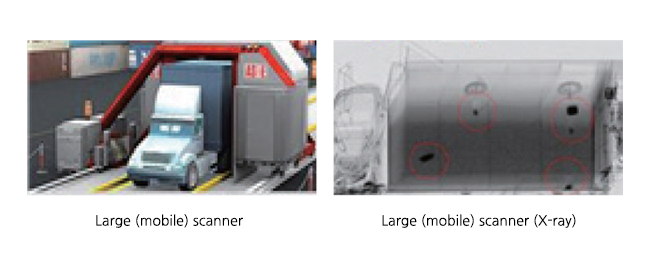
Lean More
Radiotherapy Instruments
1. Gamma Knife
• Gamma knife is treatment equipment that focuses the radiation from radioactive substances on a cancer from different directions, using a computer so that a high dose of radiation can be irradiated only to the cancerous area.
2. CyberKnife
• CyberKnife is a radiosurgery device that irradiates for cancer treatment using a navigation system from a linear accelerator mounted on a robot arm.
3. Tomotherapy
• Tomotherapy is an image-guided radiation therapy method usig three-dimensional viewing of tumor images. Tomotherapy operates by adding imaging functions, such as CT, MRI, and PET, to a radiotherapy instrument.
• Thanks to its high accuracy, tomotherapy can minimize the exposure of healthy cells to radiation.
Radiation Used in Criminal Investigations
Radiation is also used for the investigation of special crimes.
• Neutron activation analysis
• Identification of shooter in firearm crimes, determination of body hair identity, inference of environmental pollution sources, and estimation of archaeological dates, etc.
New Studies Using Radiation
Radiation, No. 1 Contributor to Eradication of Food Poisoning Bacteria
Sterilization Using Radiation
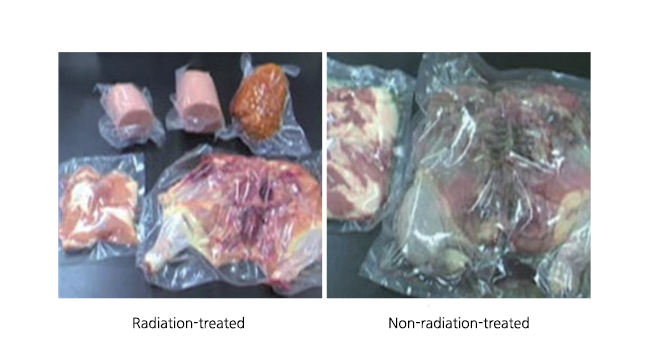
Radiation greatly contributes to our healthy life, and is applied to sterilization of food, drugs, and medical devices.
While preservatives and chemical sterilization are tightly regulated in the world because they may pose a hazard to the human body, the hygienic treatment of medical devices, drugs, and food using radiation is recommended by relevant international organizations including the World Health Organization (WHO) and Food and Agriculture Organization because radiation is recognized as 'safe to food and medical products.'
Particularly in the food industry, radiation treatment is recognized as a useful means of food poisoning prevention and food management, including the sterilization of microorganisms and harmful bacteria and the prevention of food spoilage.
Therefore, radiation also plays an important role in facilitating the international trade of agricultural products.
New Variety Development by Radiation
Radiation Breeding Technology
Irradiating plants allows us to change existing traits or improve a variety to have different genetic functions. Radiation mutagenesis has been used in various food and horticulture studies to develop crops that are strong to blight, have special functionalities, and replace imported crops.

Purification of Polluted Wastewater
Degradation of wastewater pollutants by radiation
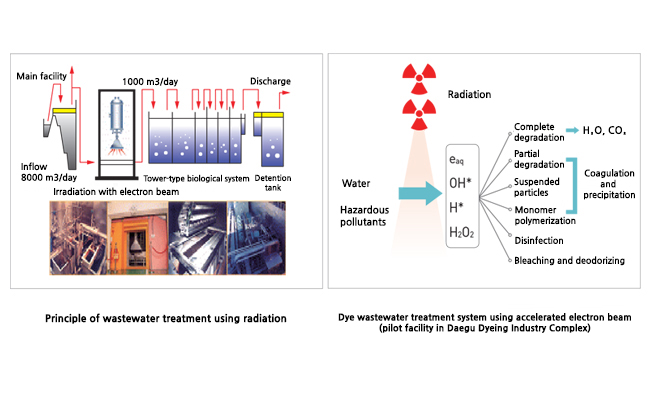
Water purification technology based on radiation, especially gamma-rays, are methods for completely eliminating water pollutants by using the strong oxidizing, reducing, and disinfecting power generated by the ionization of water. In contrast to conventional treatment technologies, this technology causes no additional pollutants, requires a simple facility, and has a short treatment time. An actual system for treating dye wastewater using radiation is installed in the Daegu Dyeing Industry Complex. Instead of treating the wastewater by using a large amount of chemicals, radiation is used to remove the toxicity and degrade the pollutants biologically in the environment-friendly wastewater treatment system.
Learn More
Radiation irradiation (meat)
• Effective elimination of pathogenic microorganisms including O157 E. coli and salmonellas
• Since 2004 The US Department of Agriculture and the Food and Drug Administration has provided high school students with hamburgers treated by radiation irradiation to prevent food poisoning accidents.
International label for radiation-treated food
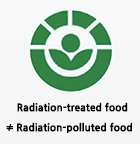
* Radiation-polluted food refers to food contaminated by radioactive substances, which is totally different than radiation-treated food.
Wastewater Purification in Daegu Dyeing Industry Complex
• Currently, over 10,000 tons of dye wastewater is treated each day using radiation in Daegu Dyeing Industry Complex.
Principle of wastewater purification using radiation
• At present, over 10,000 tons of dye wastewater is treated each day by using radiation in the Daegu Dyeing Industry Complex.
• Electron beam accelerator: An apparatus producing an electron beam of high energy by accelerating electrons emitted from an electron gun
• Ions and the excited molecules (primary products) that are formed when the accelerated electrons are absorbed by substances cause chain reactions.
• Since primary products are directly irradiated in the water, the pollutants are completely degraded and effectively removed.
Radiation Safety Management
Radiation is like a two-edged sword, which is useful but may be dangerous if misused. So, thorough safety management is necessary.
Radiation Safety Management
Radiation safety management means various activities for 'protecting people and environment from radiation.'
Three parties play important roles in radiation safety. The workers directly handling radiation and radioisotopes (RI), the employers of the workers, and the government or the regulatory authorities should thoroughly perform what they have to do to accomplish perfect management.
Radiation Management Targets
Radiation Source Management; Environment Management; Individual Management
Radiation management targets are classified as radiation sources, environment, and individuals.
Radiation Safety Management
Radiation Source Management
To manage the sources of radiation
Natural radiation sources : : Natural radiation sources are excluded from the targets of radiation management. However, natural radiation sources that may be reduced by artificial activities is the target of radiation defense.
Example) Flight attendants on jet airplanes, miners working in mines with a high natural radioactivity level
Artificial radiation sources : Artificial radiation sources are the targets of radiation management.
Environmental Management
To manage the spaces between radiation sources and people
Self-work environment management
To verify the control of radiation; to check that the radiation dose in the working environment is below the legal standard value
General environmental management
To verify the control of radiation; to check that general conditions in the environment are safe to the public
Individual Management
To manage those who are potential targets of exposure
Vocational Exposure Defense
Regular monitoring of individual dose; Monitoring of dose in workers' groups
Learn More
Need for radiation management
• Peaceful utilization of atomic energy and radiation
• Environmental preservation and prevention of damage to the public
• Prevention of physical disabilities due to radiation exposure
• Preventing radiation workers from being exposed to radiation risks during work
Three Parties' Roles
• Radiation Workers
- Observation of workers' rules and regulations (Repair education, etc.)
• Enterprises
- Radiation safety management activities (Health examination, radiation prevention education, etc.)
※ Prevention means protection from attacks and harms.
• Nuclear Safety and Security Commission (government)
- Preparation of radiation safety management standards (Regulation)
Exposure to artificial radiation sources
– Observation of three major principles of radiation defense
• Justification of practice, optimization of protection, individual dose limits
※ Radiation sources: Radiation sources refer to apparatuses or radioactive substances emitting radiation to a specimen.
Management of amount of radiation in working environment (application of legal standards)
• Space dose rate in working environment, surface contamination by radioactive substances, concentration in the air, etc.
Radiation in daily living vs Radiation for medical purposes
Utilization of radiation is safe.
Artificial radiation is used for various purposes, including medical purposes. The annual dose limit for a common person is 1 mSv. However, high-dose radiation is used for CT imaging and cancer radiotherapy, where radiation is appropriately used in specific settings for the purposes of disease diagnosis and treatment. Particularly with radiotherapy for cancer patients, even though irradiation may be with thousands of mSv, the irradiation is kept very local so that only cancer cells will be destroyed.

How can I keep my body safe from radiation?
Safety rules depending on type of radiation exposure
(1) External exposure
The outside of the body is exposed to radioactive substances.
(2) ) Internal exposure
The inside of the body is exposed to radioactive substances (gas, liquid, particles, etc.) that have entered the body.

Safety Rules Against External Exposure
Exposure of external body to radioactive substances
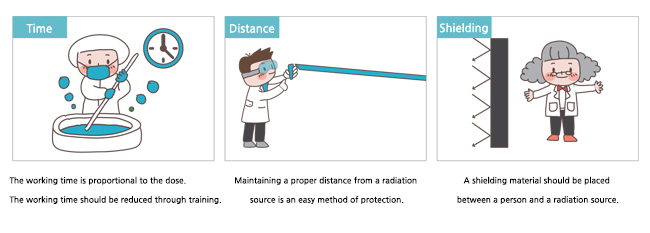
Safety Rules Against Internal Exposure
Exposure of the internal body to radioactive substances
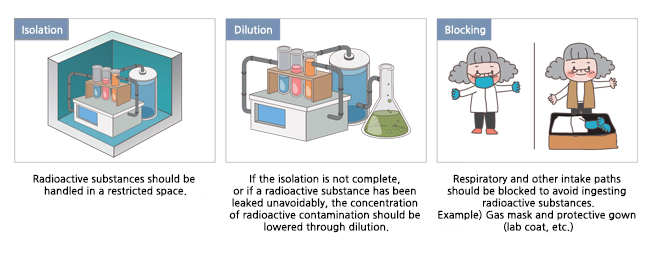
Learn More
Radiation dose
• Energy absorbed by a unit mass of material irradiated by radiation
Radiation exposure
• Exposure of human body to radiation
Dose limit
• Maximum allowable radiation dose determined by considering the effect on the human body
Effect of radiation on the human body depending on exposure dose
• Less than 250 mSv
- No clinical symptoms
• 250~3,000 mSv
- Skin erythema, hair loss, cerebral hemorrhage, leukemia, cancer
• About 4,500 mSv
- 50% chance of death within 30 days
• Over 7,000 mSv
- 100% chance of death within 30 days



